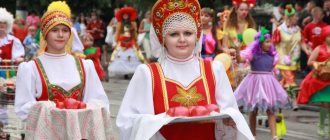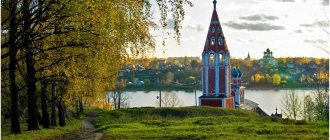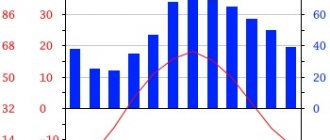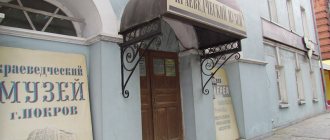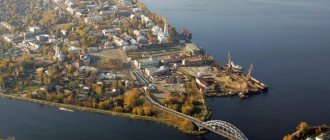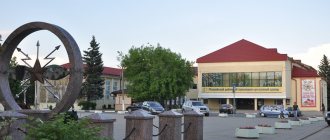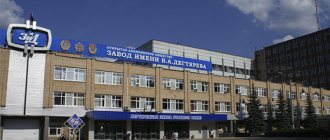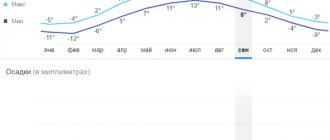| city of regional subordination with administrative territory[1] / urban district[2] | |
| Lukhovitsy city Lukhovitsy urban district | |
| Flag | Coat of arms |
- (0,76 %)
Lukhovitsky district
- an administrative-territorial unit (district) and a municipal entity of the same name (municipal district), which existed until the beginning of 2022 in the southeast of the Moscow region of Russia.
On January 10, 2022, by law No. 207/2016-OZ, the municipal formation Lukhovitsky municipal district was transformed into the municipal formation Lukhovitsy
with the abolition of all previously included settlements[5].
On April 23, 2022, the administrative-territorial unit Lukhovitsky district was transformed into the city of regional subordination of Lukhovitsy
with administrative territory.[6][7]
The administrative center is the city of Lukhovitsy. The head is Vladimir Nikolaevich Barsukov[8].
Story
Lukhovitsky district
was formed as part of the Kolomna district of the Moscow region on July 12, 1929. The district was created on part of the territory of the former Lukhovichi and Grigorievskaya volosts of the Zaraisky district of the Ryazan province. The center of the region became the village of Lukhovitsy.
The district included the following village councils: Aksenovsky, Alpatyevsky, Asoshnikovsky, Astapovsky, Bukovsky, Vlasyevsky, Volokhovsky, Vrachovsky, Vykopansky, Gavrilovsky, Gankinsky, Golovachevsky, Goltsovsky, Goretovsky, Gorodishchensky, Gorodnyansky, Grigoryevsky, Dvuglinkovsky, Dolgomostyevsky, Ivachevsky, Ivnyagovsky, Kalya Ninsky, Kareevsky, Konchakovsky, Kruglovsky, Kunakovsky, Kurovsky, Larinsky, Lukhovitsky, Matyrsky, Mukhinsky, Nizhne-Maslovsky, Novovnukovsky, Novokoshelevsky, Nosovsky, Pleshkovsky, Podlesno-Slobodsky, Psotinsky, Rudnevsky, Solchinsky, Sreznevsky, Sushkovsky, Trinity-Borkovsky and Shelukhinsky.
On May 20, 1930, Sreznevsky s/s was transferred to the Rybnovsky district.
On January 8, Lukhovitsky and Beloomutsky districts were merged into Gorkinsky district
with its center at Gorki station.
However, already on May 11, the center of the district was moved to Lukhovitsy, and the district itself was renamed Lukhovitsky district
. At that time, it included the following village councils: Aksenovsky, Alpatyevsky, Asoshnikovsky, Astapovsky, Bukovsky, Verkhne-Beloomutsky, Vlasyevsky, Volokhovsky, Vrachovsky, Vykopansky, Gavrilovsky, Gankinsky, Golovachevsky, Goltsevsky, Goretovsky, Gorodishchensky, Gorodnyansky, Grigorievsky, Dvuglinkovsky, Dedinovsky , Dolgomostevsky, Ivachevsky, Ivnyagovsky, Kalyaninsky, Kareevsky, Konchakovsky, Kruglovsky, Kunakovsky, Kurovsky, Larinsky, Letovsky, Lovetsky, Lovetsko-Borkovsky, Lukhovitsky, Lyubichevsky, Matyrsky, Mukhinsky, Nizhne-Beloomutsky, Nizhne-Maslovsky, Novovnukovsky, Novokoshelevsky , Nosovsky , Nudovshinsky, Pleshkovsky, Podlesno-Slobodsky, Psotinsky, Radovitsky, Rudnevsky, Sazonovsky, Slemsko-Borkovsky, Solchinsky, Sushkovsky, Trinity-Borkovsky and Shelukhinsky.
On April 21, 1934, Letovsky, Radovitsky and Sazonovsky s/s were transferred to the Yegoryevsky district.
In 1935, Ivnyagovsky s/s was renamed Ozeritsky.
On April 4, 1939, Nudovshinsky s/s was renamed Lesnoy. On July 7, the working settlement of Beloomut was formed, and the Verkhne-Beloomutsky and Nizhne-Beloomutsky s/s were abolished. On July 17, Bukovsky, Volokhovsky, Gankinsky, Goretovsky, Dolgomostevsky, Kalyaninsky, Lovetsko-Borkovsky, Psotinsky, Sushkovsky and Shelukhinsky s/s were abolished.
On June 2, 1948, the r.p. was formed. Lukhovitsy.
On June 14, 1954, Asoshnikovsky, Astapovsky, Vlasyevsky, Golovachevsky, Gorodishchensky, Ivachevsky, Kareevsky, Kruglovsky, Kurovsky, Larinsky, Mukhinsky, Novokoshelevsky, Pleshkovsky, Podlesno-Slobodsky, Rudnevsky and Trinity-Borkovsky s/s were abolished.
On December 26, 1956, Vykopansky s/s was abolished.
June 20, 1957 r.p. Lukhovitsy was transformed into a city (Decree of the Presidium of the Supreme Soviet of the RSFSR) (Vedomosti of the Supreme Soviet of the USSR. - 1957. - No. 16 (883) of August 14. - P. 527).
On July 31, 1959, Vrachovsky s/s was abolished. Novovnukovsky s/s was renamed to Astapovsky, Solchinsky s/s - to Fruktovsky, Dvuglinkovsky - to Krasnopoimovsky. On November 5, the Kunakovsky and Lukhovitsky s/s were abolished.
On August 20, 1960, Ozeritsky s/s was renamed Vykopansky.
On February 1, 1963, the Lukhovitsky district was abolished. City of Lukhovitsy and r.p. Beloomut was transferred to the subordination of the city of Kolomna, and the village councils were transferred to the Kolomna enlarged rural district.
On January 13, 1965, the Lukhovitsky district was restored. It included the city of Lukhovitsy, r.p. Beloomut, as well as village councils: Aksenovsky, Alpatyevsky, Astapovsky, Vykopansky, Gavrilovsky, Goltsovsky, Gorodnyansky, Grigoryevsky, Dedinovsky, Konchakovsky, Krasnopoimovsky, Lovetsky, Lyubichsky, Matyrsky, Nizhnemaslovsky, Nosovsky, Slemsko-Borkovsky and Fruktovsky.
On May 6, 1980, the Slemsko-Borkovsky s/s was abolished.
On February 3, 1994, village councils were transformed into rural districts.
On February 25, 1998, Lyubichsky s/o was abolished[10].
On January 9, 2022, Law No. 207/2016-OZ transformed the Lukhovitsky municipal district into the Lukhovitsy urban district with the abolition of all settlements. Lukhovitsky district as an administrative-territorial unit has not yet been abolished[11].
On January 10, 2022, by law No. 207/2016-OZ, the municipal formation Lukhovitsky municipal district was transformed into the municipal formation urban district of Lukhovitsy with the abolition of all 2 urban and 6 rural settlements that were previously included in it[5].
On March 14, 2022, the rural settlements of Astapovskoye, Gazoprovodskoye, Golovachevskoye, Dedinovskoye, Krasnopoimovskoye and Fruktovskoye were abolished (Resolution of the Governor of the Moscow Region dated March 14, 2022 No. 89-PG, Official Internet portal of the Government of the Moscow Region https://www.mosreg.ru, 03/14/2017).
On March 29, 2022, the working village of Beloomut was placed under the administrative subordination of the city of Lukhovitsy (Resolution of the Governor of the Moscow Region dated March 29, 2022 No. 126-PG, Official Internet portal of the Government of the Moscow Region https://www.mosreg.ru, 03.29.2017).
On April 23, 2022, the administrative-territorial unit Lukhovitsky district was transformed into a city of regional subordination with an administrative territory[6][7].
City monuments
Despite its modest size, Lukhovitsy can boast of several sculptures. There are literary ones, ones dedicated to historical figures, and more “fun” options, for example, a monument to the cucumber, which has become an unspoken symbol of the city.
Eternal Flame at the Walk of Fame
Below are descriptions of the most interesting and beloved compositions by Lukhovichi residents, but this is an incomplete number: in the city there is a monument to the victims of political repression, a sculpture of Lenin, internationalist soldiers, an eternal flame and the Walk of Fame complex.
Monument to postman Pechkin
You can find it on Zhukovsky Street near house No. 2, where the city post office is located. The composition was installed in 2008, in honor of the 50th anniversary of the holiday of communications.
This is interesting: many believe that its installation was also timed to coincide with the 50th anniversary of the city, but in the year of installation the Lukhovits turned 51 years old.
The two-meter postman is cast from bronze. It represents a whole composition: in the center is the postman Pechkin himself, sitting on a bicycle. There is a mail bag slung over his shoulder, and a little jackdaw on his right shoulder. A happy cat Matroskin is standing near the bicycle, and a dog Sharik is sitting.
Monument to Cucumber
Cucumbers grown in Lukhovitsy have long been famous for their high taste, but they have never been grown in public production. Vegetables were grown on private plots: first on peasant plots, and from the second half of the 60s of the twentieth century - on dachas located in the Oka floodplain. Such vegetable growing allowed owners to receive additional, and sometimes main income.
The monument is located on the M-5 highway (Novoryazanskoye Highway), near the intersection with Pushkin Street. It was installed in 2007 on the day of the 50th anniversary of the city and quickly became the calling card of Lukhovitsy. The monument looks like a “wooden” barrel with a cucumber standing on it. The cucumber is supported by carved leaves, from which coins peek out - rubles and kopecks.
There is a sign on the barrel: “To the cucumber-breadwinner from grateful Lukhovichi residents.”
It is worth noting: a small figurine identical to the installed monument is located in the office of the administration of the town of Rybnoye.
Monument to MiG-23
It can be found at the intersection of the street. Zhukovsky with Bolnichny Proezd, the exact address is Zhukovsky Street, building 18. Erected on the playground in Lukhovitsky Central Park, not far from the Start Palace of Culture.
Its installation is connected with the aircraft construction branch operating in Lukhovitsy, which assembles aircraft. Due to the expansion of aircraft production, Lukhovitsy developed and received the status of a city, but at the same time the place became closed and classified.
Please note: another MiG monument stands in front of the plant itself, but a different model is presented there - the MiG-23UB.
The composition represents a multi-role fighter bursting upward with variable sweep wings. It was these models that were the first Soviet fighters that appeared first in the city, and then in the country.
Monument to Aibolit
This sculpture can hardly be called serious, but, nevertheless, children love it very much. The monument to Doctor Aibolit was erected at 17 Mira Street, in the courtyard of the children's clinic. It appeared in 2008.
This is interesting: in the photographs you can see that the cross on the doctor’s suitcase is very worn - perhaps this is due to the sign of rubbing it for good luck or health.
The composition represents Aibolit sitting on the steps, holding a doctor’s suitcase with a cross on his knees. Behind him “grow” two trees with intertwined crowns. Animals and birds sit in the foliage: owl, squirrels, hippopotamus, monkey, whale and others.
Monument to A.S. Pushkin
Few visiting tourists know that such a monument even stands in the city, although the stone poet appeared here at the end of the 20th century. And although in fact nothing connects Alexander Sergeevich with the city (unlike Peter I, whose navy was born in a nearby village), the monument is still loved by the residents. In 2009, they planned to build a McDonald's in its place, but residents defended the poet: instead of demolition, they named a square in his honor.
It is worth noting: in the 90s of the twentieth century, 2 monuments to Pushkin were erected - a full-length one and a bust, the latter was repeatedly attacked by hooligans.
The sculpture represents Pushkin standing at full height, with a cloak on his left shoulder. The monument is decorated with a plaque with lines from the poem “I erected a monument to myself not made by hands.”
Monument to Peter I
The first Russian emperor is immortalized in a huge number of busts and sculptures, one of which is located in Lukhovitsy. Such an unusual choice is due to the fact that the first Russian warship was launched on the Oka River in the village of Dedinovo, near Lukhovitsy.
Please note: the monument is located at Pushkin Street, building number 2, but sometimes the address is Sovetskaya Street, building 8A - this is the address of the Historical and Art Museum, in front of which the sculpture stands.
The two-meter (including pedestal) monument represents the figure of Peter the Great standing on the bow of the ship and looking into the distance. Next to it, on a separate pedestal, lies an anchor and the words “For my Fatherland and people I have not and do not regret my life... Peter I” are carved.
Population
| Population | |||||
| 1939[12] | 1959[13] | 1970[14] | 1979[15] | 1989[16] | 2002[17] |
| 61 459 | ↘57 156 | ↗57 464 | ↗62 611 | ↗65 534 | ↘63 235 |
| 2006[18] | 2009[19] | 2010[20] | 2011[21] | 2012[22] | 2013[23] |
| ↘62 552 | ↘62 509 | ↘58 802 | ↗58 853 | →58 853 | ↗58 881 |
| 2014[24] | 2015[25] | 2016[26] | 2017[4] | ||
| ↘58 669 | ↗58 747 | ↘58 635 | ↗58 648 | ||
Urbanization
62.19% of the district's population live in urban areas (the city of Lukhovitsy and the working village of Beloomut).
How to get to Lukhovits
From Moscow you can do this in different ways:
- By train from the Kazansky station in Moscow, their path lies through the Lukhovitsy station.
Take note: the Moscow-Ryazan express train also passes the indicated station, the travel time takes about two hours.
- By bus: you can get there by bus No. 318, you can also use routes No. 330 to Zaraysk and No. 960 to Ryazan. All of them depart from the Kotelniki metro station.
- On your own: the M-5 highway or Novoryazanskoe highway stretches from Moscow to the city; you will have to travel 130-135 km along it.
You can also get to the nearest cities, and from there to Lukhovitsy: the distance from Kolomna is 22 km, from Ryazan – 54 km. Both cities are located on the same highway, so it will be easy to travel.
Lukhovitsy is a small town in the Moscow region with a population of about 30 thousand people. But despite its size, it attracts many tourists, as well as lovers of “wild” holidays from nearby places and even from Moscow.
We bring to your attention an interesting video about the city of Lukhovitsy:
Municipal-territorial structure
From 2006 to 2022, the Lukhovitsky municipal district included 2 urban and 6 rural settlements:
| № | Urban and rural settlements | Administrative center | Number of settlements | Population | Area[27], km2 |
| 1 | Urban settlement Beloomut | working village of Beloomut | 5 | ↘6107[4] | 263,25 |
| 2 | Urban settlement of Lukhovitsy | Lukhovitsy city | 2 | ↗30 312[4] | 117,01 |
| 3 | Rural settlement Astapovskoye | village of the state farm "Astapovo" | 21 | ↘3506[4] | 188,00 |
| 4 | Rural settlement Gazoprovodskoye | Gazoprovodsk village | 30 | ↘4872[4] | 255,25 |
| 5 | Rural settlement Golovachevskoye | Golovachevo village | 14 | ↘3607[4] | 69,25 |
| 6 | Rural settlement Dedinovskoye | village of Dedinovo | 9 | ↘3379[4] | 276,25 |
| 7 | Rural settlement Krasnopoimovskoye | Krasnaya Poima village | 3 | ↗3357[4] | 67,50 |
| 8 | Rural settlement Fruktovskoye | Fruktovaya village | 9 | ↘3508[4] | 91,00 |
On January 10, 2022, all settlements were abolished with the transformation of the municipal district into an urban district.
Natural objects and bodies of water
The town is located in a picturesque place; mixed forests grow nearby, especially in the mountainous part.
Please note : most of the forest used to be coniferous, but today they have been replaced by mixed forests, linden forests, and oak forests.
Initially, there were a lot of swamps on the territory of the village, but in the second half of the 20th century they began to actively dry out. In their place, hayfields and pastures appeared. The same fate befell many small lakes and rivers, but still there are several important natural sites in the region, including six protected areas. Here you can also find plants and animals listed in the Red Book, for example, river beavers.
River Voblya
The river with such a dissonant name flows from the south of Lukhovitsy and flows into the Oka. Its length is 36 km, the basin area is almost 230 square meters. km. This is a flat river that “feeds” on snow and has one tributary – the Chernaya River. At the end of November - beginning of December, Voblya freezes until the end of March - beginning of April. The upper reaches of the river are densely populated, while below it flows through a series of narrow lakes, which are the main attraction for many tourists and fishermen.
It is worth considering: some sources indicate a length of 29 km.
Linguists believe that the name “Voblya” is adjacent to the base “Obl” (“Round”), which was known even among the Proto-Slavs. Another option is the Proto-Slavic word “Vabiti” (“Beckon”). Some linguists see the Baltic origin of the name: “Woble” (Ancient Prussia) and “Vabalas” (Lithuania) - “Apple”, “Wabule” (Latvia) - “Bug”.
However, popular rumor explains the name differently. One morning in the spring, when the ice had not yet melted, one of the rulers of Rus' (the name could be anything - from Rurik to Peter I) and his retinue crossed the river without much difficulty. When he returned in the evening, the ice had melted, and the river overflowed heavily. Angry, the ruler pronounced the name of the river, but in two words.
Blue Lakes
These are several artificial reservoirs, which are located north of Lukhovitsy and 130 km from Moscow, travel along the Novoryazanskoe highway. Previously, there were sand pits here, but they were gradually flooded, making them available to vacationers. The oldest lake is over 60 years old.
Thanks to its favorable location, Blue Lakes quickly became popular among local residents and Muscovites: pine forest, clean water, sandy beaches, convenient access and access to the water. The first two lakes are located close to the road and are mostly used by families visiting for the day.
It’s worth considering: if you drive further (about 20-30 minutes by car due to the inability to reach high speed), you can find three more lakes where people come with tents. Much fewer people stay there and there are regular bards' gatherings, the most famous of which takes place on the first weekend of summer. This is the annual gathering of the author's song "Lukhovitsky Lakes", until 2010 the festival "Blue Lakes" was held.
Settlements
Main article: List of settlements in Lukhovitsky district
List of settlements
| № | Locality | Type | Population | former municipality |
| 1 | Aksyonovo | village | ↘389[28] | rural settlement Golovachevskoye |
| 2 | Alpatyevo | village | ↘231[28] | rural settlement Gazoprovodskoye |
| 3 | Asoshniki | village | ↘90[28] | rural settlement Astapovskoye |
| 4 | Astapovo | village | ↘155[28] | rural settlement Astapovskoye |
| 5 | Astapovo | village | ↘19[28] | rural settlement Gazoprovodskoye |
| 6 | Badgers | village | ↘43[28] | rural settlement Gazoprovodskoye |
| 7 | Beloomut | workers' village | ↗6032[29] | urban settlement Beloomut |
| 8 | Belyaevo | village | ↗1[28] | rural settlement Fruktovskoye |
| 9 | Berkhino | village | ↘7[28] | rural settlement Astapovskoye |
| 10 | Bukovo | village | ↘47[28] | rural settlement Fruktovskoye |
| 11 | Bulgakovo | village | ↗13[28] | rural settlement Astapovskoye |
| 12 | Vlasyevo | village | ↘21[28] | rural settlement Astapovskoye |
| 13 | Volokhovo | village | ↗11[28] | rural settlement Gazoprovodskoye |
| 14 | Vrachovo | village | ↗201[28] | rural settlement Fruktovskoye |
| 15 | Vrachovo-Gorki | village | ↘782[28] | rural settlement Fruktovskoye |
| 16 | Dig up | village | ↗359[28] | rural settlement Golovachevskoye |
| 17 | Gavrilovskoe | village | ↗104[28] | rural settlement Gazoprovodskoye |
| 18 | Gazoprovodsk | village | ↘1134[28] | rural settlement Gazoprovodskoye |
| 19 | Gankino | village | ↘78[28] | rural settlement Gazoprovodskoye |
| 20 | Waterworks | village | ↘16[28] | urban settlement Beloomut |
| 21 | Golovachevo | village | ↘1055[28] | rural settlement Golovachevskoye |
| 22 | Golny Bugor | village | →28[28] | rural settlement Dedinovskoye |
| 23 | Goltsovo | village | ↗31[28] | rural settlement Golovachevskoye |
| 24 | Goretovo | village | ↗95[28] | rural settlement Krasnopoimovskoye |
| 25 | Settlement | village | ↘10[28] | rural settlement Gazoprovodskoye |
| 26 | Settlement | village | ↘70[28] | rural settlement Golovachevskoye |
| 27 | Gorodna | village | ↘476[28] | rural settlement Astapovskoye |
| 28 | Grigorievskoe | village | ↘690[28] | rural settlement Gazoprovodskoye |
| 29 | Duglinkovo | village | ↘152[28] | rural settlement Krasnopoimovskoye |
| 30 | Dedinovo | village | ↘1863[28] | rural settlement Dedinovskoye |
| 31 | Dolgomostevo | village | ↘45[28] | rural settlement Gazoprovodskoye |
| 32 | Foalers | village | →2[28] | rural settlement Gazoprovodskoye |
| 33 | Zekzyulino | village | →4[28] | rural settlement Astapovskoye |
| 34 | Zolotukhino | village | →0[28] | rural settlement Astapovskoye |
| 35 | Ivachevo | village | ↘19[28] | rural settlement Golovachevskoye |
| 36 | Ivnyagi | village | ↘113[28] | rural settlement Fruktovskoye |
| 37 | Ignatyevo | village | →2[28] | rural settlement Astapovskoye |
| 38 | Ilyasovo | village | ↘8[28] | rural settlement Astapovskoye |
| 39 | Kadanok | village | ↘34[28] | urban settlement Beloomut |
| 40 | Kalyaninskoe | village | ↘29[28] | rural settlement Gazoprovodskoye |
| 41 | Kareevo | village | ↘74[28] | rural settlement Gazoprovodskoye |
| 42 | Klementyevo | village | ↗3[28] | rural settlement Astapovskoye |
| 43 | Konchakovo | village | ↗39[28] | rural settlement Gazoprovodskoye |
| 44 | Krasnaya Poyma | village | ↘3051[28] | rural settlement Krasnopoimovskoye |
| 45 | Kruglovo | village | ↗129[28] | rural settlement Astapovskoye |
| 46 | Kurovo | village | ↘120[28] | rural settlement Gazoprovodskoye |
| 47 | Larino | village | ↗109[28] | rural settlement Golovachevskoye |
| 48 | Lesnoye | village | ↘12[28] | rural settlement Dedinovskoye |
| 49 | Fox Holes | village | ↗419[28] | rural settlement Dedinovskoye |
| 50 | Lovetskie Borki | village | ↘30[28] | rural settlement Dedinovskoye |
| 51 | Catchers | village | ↘1073[28] | rural settlement Dedinovskoye |
| 52 | Lukhovitsy | city | ↗30 443[29] | urban settlement Lukhovitsy |
| 53 | Luchkansy | village | ↗7[28] | rural settlement Gazoprovodskoye |
| 54 | Lubitsch | village | ↘206[28] | rural settlement Dedinovskoye |
| 55 | Maryina Gora | village | ↘86[28] | rural settlement Gazoprovodskoye |
| 56 | Matveevka | village | ↘17[28] | rural settlement Gazoprovodskoye |
| 57 | Matyra | village | ↗988[28] | rural settlement Astapovskoye |
| 58 | Mokhovoe | village | ↘0[28] | urban settlement Beloomut |
| 59 | Mukhino | village | ↘45[28] | rural settlement Gazoprovodskoye |
| 60 | Nizhne-Maslovo | village | ↘555[28] | rural settlement Gazoprovodskoye |
| 61 | Novokoshelevo | village | →78[28] | rural settlement Gazoprovodskoye |
| 62 | Novokunakovo | village | ↘37[28] | rural settlement Astapovskoye |
| 63 | Novokhodykino | village | ↘1[28] | rural settlement Astapovskoye |
| 64 | Nosovo-1 | village | ↗61[28] | rural settlement Gazoprovodskoye |
| 65 | Nosovo-2 | village | ↘62[28] | rural settlement Gazoprovodskoye |
| 66 | Ozeritsy | village | ↘144[28] | rural settlement Fruktovskoye |
| 67 | Olshany | village | ↗8[28] | rural settlement Dedinovskoye |
| 68 | Oreshkovo | village | ↗61[28] | rural settlement Gazoprovodskoye |
| 69 | Pavlovskoe | village | ↗653[28] | rural settlement Gazoprovodskoye |
| 70 | Perevitsky Torzhok | village | ↗291[28] | rural settlement Fruktovskoye |
| 71 | Pleshki | village | ↗64[28] | rural settlement Astapovskoye |
| 72 | Podlesnaya Sloboda | village | ↗306[28] | rural settlement Golovachevskoye |
| 73 | Sublips | village | ↘9[28] | rural settlement Golovachevskoye |
| 74 | Village of the Dedinovo state farm branch | village | ↗33[28] | rural settlement Dedinovskoye |
| 75 | The village of the state farm "Astapovo" | village | ↘1224[28] | rural settlement Astapovskoye |
| 76 | The village of Chernaya station | railway station village | ↗41[4] | urban settlement Lukhovitsy |
| 77 | Protasovo | village | ↗4[28] | rural settlement Gazoprovodskoye |
| 78 | Psotino | village | ↘288[28] | rural settlement Golovachevskoye |
| 79 | Rudnevo | village | ↗14[28] | rural settlement Gazoprovodskoye |
| 80 | Sarybyevo | village | →31[28] | rural settlement Astapovskoye |
| 81 | Agricultural machinery | village | ↘764[28] | rural settlement Golovachevskoye |
| 82 | Slemskie Borki | village | ↘11[28] | urban settlement Beloomut |
| 83 | Solchino | village | ↘98[28] | rural settlement Fruktovskoye |
| 84 | Starovnukovo | village | ↘0[28] | rural settlement Astapovskoye |
| 85 | Starokoshelevo | village | ↗48[28] | rural settlement Gazoprovodskoye |
| 86 | Starokhodykino | village | ↗26[28] | rural settlement Astapovskoye |
| 87 | Stroilovo | village | ↗45[28] | rural settlement Golovachevskoye |
| 88 | Torzhnevo | village | ↘0[28] | rural settlement Golovachevskoye |
| 89 | Trinity Borki | village | ↗75[28] | rural settlement Astapovskoye |
| 90 | Tyunino | village | ↘35[28] | rural settlement Gazoprovodskoye |
| 91 | Fedorovskoe | village | →10[28] | rural settlement Gazoprovodskoye |
| 92 | Fruity | village | ↘1763[28] | rural settlement Fruktovskoye |
| 93 | Chuprikovo | village | ↗56[28] | rural settlement Golovachevskoye |
Temples, monasteries, holy places
Lukhovitsy, whose attractions attract travelers seeking peace and quiet, has many religious monuments.
Holy spring of St. Nicholas the Wonderworker
20 km west of Lukhovitsa is the village of Gorodna, on the southern outskirts of which there is a holy spring, consecrated in the name of St. Nicholas the Wonderworker. Several ice springs gush out on the side of a limestone mountain and flow down in small streams to a wooden bathhouse.
A small wooden temple was installed above it in 2003, with a bench installed in front of the entrance. Water flows from the source in 3 streams. They are lined with limestone stones. The area surrounding the spring has been landscaped by local parishioners. There is a large paved parking lot adjacent to the spring. Next to it you can buy plastic containers for water.
You can collect water and dive into the pool every day at any time of the year. It should be taken into account that on religious holidays a large number of pilgrims gather at the source.
Holy spring of Paraskeva Friday
In the suburban village of Podlesnaya Sloboda on the banks of the river. Voblya is located a spring revered by the local population. According to believers, its water helps get rid of many diseases, including those considered incurable.
In 2022, in place of a simple covered well, a font and a place for collecting water appeared. A new bridge was built to the ancient temple standing on the opposite bank, over which on church holidays a procession of the cross to the source is made.
Vvedenskaya Church
One of the popular attractions of the Lukhovitsky district is the Vvedensky Church, located in the village of Podlesnaya Sloboda. The church, built of red brick, was consecrated in 1874. In 1916, the famous writer K. G. Paustovsky got married here. From 1936 to 1994 the temple was closed. Today the church is in a state of restoration.
The temple is located at Lukhovitsky district, village. Podlesnaya Sloboda, possession 206.
Church of the Nativity
In 2000, at the address st. Zhukovsky, 41 there was a small temple made of red brick, crowned with one gilded dome. In addition to the main church in honor of the Nativity of Christ, in the basement there is a baptismal church in honor of the holy Equal-to-the-Apostles Prince Vladimir the Baptist.
The temple attracts tourists and pilgrims with many unique icons, each of which contains a piece of holy relics.
Church of St. Nicholas the Wonderworker
One of the architectural monuments of the city, built at the beginning of the 20th century, is the cemetery church in the name of St. Nicholas the Wonderworker. It is a single-domed red brick temple, designed in pseudo-Russian style. The temple, severely destroyed during the years of Soviet power, has been under reconstruction since 1994. The church is located in the area of the street. Kuibysheva.
Church of the Life-Giving Trinity
In the south of Lukhovitsy at Troitsky proezd, 1 at the beginning of the 21st century. a temple complex appeared, consisting of the following buildings:
- temple in the name of the Life-Giving Trinity;
- Church in the name of St. Sergius of Radonezh.
In the Trinity Church there is a small chapel, consecrated in honor of the Lukhovitsk confessors and new martyrs.
Kazan Church in Sushkovo
In the area of the village of Sushkovo, which today is part of the city limits of Lukhovitsy, there is the oldest religious building - the church in the name of the Kazan Icon of the Mother of God. It was erected in 1754 at the expense of the local landowner I.V. Svechin.
The wooden temple, a classic Russian design of an octagon on a quadrangle, stands on a solid stone foundation. Thanks to the material used in the construction of the walls, the Kazan Church is considered a unique building. Despite the desolation during Soviet times, the building was well preserved. The interior decoration preserves a linden carved iconostasis and wall paintings from the 2nd half of the 19th century.
The doors of the temple are open to parishioners and tourists daily from 8 a.m. to 4 p.m.
Don't miss the most popular article in the section: Crocus City Hall in Moscow - layout of the hall with seats, photos, capacity, address, how to get there, how to get there by metro.
Policy
The head of the Lukhovitsky municipal district is the head of the district.
Communist Anatoly Alekseevich Mikhailov, who held this position since March 5, 2009, resigned at his own request due to deteriorating health. On May 12, 2014, the Council of Deputies of the Lukhovitsky Municipal District accepted the resignation.
The head of the Lukhovitsky municipal district is elected by the Council of Deputies of the Lukhovitsky District from among its members. The head of the district administration is appointed to work under a contract.
All Russian political parties are represented in the district.
Famous people
Despite its “modest” size, the city has its own famous personalities:
- The main one is test pilot Ivan Grigorievich Vorobiev - this Hero of the Soviet Union died while testing the aircraft. A street was named in his honor and a monument was also erected;
- No less famous is Captain Zubachev Ivan Nikolaevich, who led the defense of the Citadel of the Brest Fortress. He was captured in 1944 and died in the infirmary less than a month later;
Monument to test pilot I.G. Vorobyov
It is important to know: those who died in the Second World War and local military conflicts were not forgotten - the Alley of Heroes was opened near the Chernaya River.
- In 1965-1995, test pilot Yuri Garrievich Abramovich worked here. He tested MiG-21, Mig-23, Mig-29 and Il-103 fighters;
- In 1937, Bishop Theodosius died in the Lukhovitsk region (the village of Sushkovo), who was canonized in 2006.
Notes
- from the point of view of the administrative-territorial structure
- from the point of view of the municipal structure
- Law of the Moscow Region N 55/2017-OZ dated 04/21/2017 as amended as of 07/17/2018 On the border of the Lukhovitsy urban district
- ↑ 1234567891011
Population of the Russian Federation by municipalities as of January 1, 2022 (Russian) (July 31, 2017). Retrieved July 31, 2022. Archived July 31, 2022. - ↑ 12
Law “On the organization of local self-government in the territory of the Lukhovitsky municipal district” - ↑ 12
Law “On classifying the city of Lukhovitsy, Lukhovitsky district, Moscow region, as a city of regional subordination of the Moscow region, abolishing the Lukhovitsky district of the Moscow region and amending the Law of the Moscow region “On the administrative-territorial structure of the Moscow region”” - ↑ 12
Law of the Moscow Region No. 11/2013-OZ dated January 31, 2013 “On the administrative-territorial structure of the Moscow Region” - Early elections of the Head of the Lukhovitsky municipal district of the Moscow region 07/06/2014 (unspecified)
. Election Commission of the Moscow Region. Access date: August 6, 2014. - Law of the Moscow Region dated 02.12.2011 No. 209/2011-OZ “On amendments to the Law of the Moscow Region “On the status and boundaries of the Lukhovitsky Municipal District and newly formed municipalities within it”” (adopted by Resolution of the Moscow Regional Duma dated 24.11.2011 No. 11/ 176-P)
- Handbook on the administrative-territorial division of the Moscow region 1929-2004. - M.: Kuchkovo pole, 2011. - 896 p. — 1500 copies. — ISBN 978-5-9950-0105-8.
- Law of the Moscow Region No. 207/2016-OZ “On the organization of local self-government in the territory of the Lukhovitsky municipal district”
- All-Union Population Census of 1939. The current population of the USSR by regions and cities (unspecified)
. Retrieved November 20, 2013. Archived November 16, 2013. - All-Union Population Census of 1959. The actual population of cities and other settlements, districts, regional centers and large rural settlements as of January 15, 1959 by republics, territories and regions of the RSFSR (unspecified)
. Retrieved October 10, 2013. Archived October 10, 2013. - All-Union population census of 1970. The actual population of cities, urban-type settlements, districts and regional centers of the USSR according to census data as of January 15, 1970 by republic, territory and region (unspecified)
. Retrieved October 14, 2013. Archived October 14, 2013. - All-Union Population Census of 1979. The current population of the RSFSR, autonomous republics, autonomous regions and districts, territories, regions, districts, urban settlements, village-district centers and rural settlements with a population of over 5,000 people (unspecified)
. - All-Union population census of 1989. Population of the USSR, RSFSR and its territorial units by gender (undefined)
. Archived from the original on August 23, 2011. - All-Russian population census 2002. Volume. 1, table 4. Population of Russia, federal districts, constituent entities of the Russian Federation, districts, urban settlements, rural settlements - regional centers and rural settlements with a population of 3 thousand or more (unspecified)
. Archived from the original on February 3, 2012. - Alphabetical list of settlements in municipal districts of the Moscow region as of January 1, 2006 (unspecified)
(RTF+ZIP). Development of local self-government in the Moscow region. Access date: February 4, 2013. Archived January 11, 2012. - The size of the permanent population of the Russian Federation by cities, urban settlements and regions as of January 1, 2009 (unspecified)
. Retrieved January 2, 2014. Archived January 2, 2014. - Population census 2010. Population of Russia, federal districts, constituent entities of the Russian Federation, city districts, municipal districts, urban and rural settlements (Russian). Federal State Statistics Service. Access date: February 9, 2013. Archived April 28, 2013.
- Moscow region. Estimated resident population as of January 1, 2009-2016
- Population of the Russian Federation by municipalities. Table 35. Estimated resident population as of January 1, 2012 (unspecified)
. Retrieved May 31, 2014. Archived May 31, 2014. - Population of the Russian Federation by municipalities as of January 1, 2013. - M.: Federal State Statistics Service Rosstat, 2013. - 528 p. (Table 33. Population of urban districts, municipal districts, urban and rural settlements, urban settlements, rural settlements) (undefined)
. Retrieved November 16, 2013. Archived November 16, 2013. - Table 33. Population of the Russian Federation by municipalities as of January 1, 2014 (unspecified)
. Access date: August 2, 2014. Archived August 2, 2014. - Population of the Russian Federation by municipalities as of January 1, 2015 (unspecified)
. Access date: August 6, 2015. Archived August 6, 2015. - Population of the Russian Federation by municipalities as of January 1, 2016 (Russian) (October 5, 2018). Retrieved May 15, 2022. Archived May 8, 2022.
- Moscow region. Total land area of the municipality
- ↑ 1 2 3 4 5 6 7 8 9 10 11 12 13 14 15 16 17 18 19 20 21 22 23 24 25 26 27 28 29 30 31 32 33 34 35 36 37 38 39 40 41 42 43 44 45 46 47 48 49 50 51 52 53 54 55 56 57 58 59 60 61 62 63 64 65 66 67 68 69 70 71 72 73 74 75 76 77 78 79 80 81 82 83 84 85 86 87 88 89 90 Chi population of the rural population and its distribution on the territory of
the Moscow region region (results of the 2010 All-Russian Population Census).
Volume III (undefined)
(DOC+RAR). M.: Territorial body of the Federal State Statistics Service for the Moscow Region (2013). Retrieved October 20, 2013. Archived October 20, 2013. - ↑ 1 2
Estimation of the permanent population of the Moscow region as of January 1, 2022 and on average for 2022 for municipalities
(unspecified)
. Mosoblaststat. Access date: April 20, 2022.
Sights of the city of Lukhovitsy
Due to the modest size of the town, it may seem that there is nothing to see here, but this is not true. Lukhovitsy is home to several interesting museums and temples, as well as interesting and unusual sculptures.
Buildings and constructions
Lukhovitsy cannot boast of particularly rich architectural features: the city developed after the Second World War, and today it is a mixture of wooden private houses and small houses of 2-4 floors. Taller buildings are gradually appearing in the center.
Station square Lukhovits
In Lukhovitsy there are several libraries and schools, a gymnasium and three lyceums, a branch of the Moscow Pedagogical University and a branch of the Russian Academy of Tourism (College of Management), a music school and a center for the development of creativity, and several museums. Sports life is represented by a stadium, a health complex and a children's sports school.
Museum of Local Lore
It is also called the historical and art museum. The building is made in the form of a carved mansion with a hipped roof that stretches to the ground. From a distance, this shape resembles a wigwam. The exhibition is dedicated to the history of the town from its very foundation, as well as the current state and representatives of the local flora and fauna.
In the first hall, visitors will find everyday items that were used by residents several centuries ago: clothes and shoes, weapons, farming tools, spinning wheels, dishes, icons, watches and much more. Dinosaur bones, models of ancient fortresses and the first warship, money, certificates and more are also presented.
In the second hall, the exhibition concerns flora and fauna: stuffed animals and birds living in the region are presented here.
The third room concerns the times of the Second World War and a description of how local residents lived those years. Military uniforms, documents, weapons and personal belongings of those who fought are presented here. In the center of the hall, on red columns, the names of all Lukhovichi residents and residents of the area who died in the war are written.
There is no permanent exhibition in the fourth hall: temporary exhibitions are held there.
Address: Sovetskaya street, building 8A.
Opening hours: Tuesday to Sunday from 8:00 to 17:00;
Phone: (49663) 218-92, -96;
Ticket price: 10-50 rubles.
Please note: the museum is located near the station, next to the city administration.
Exhibition of military equipment
This exposition was located in the open air in front of the mountain administration building. Exact address: Sovetskaya street, building 7.
Military equipment is presented here: the L-29 jet trainer, the T-55 medium tank, the MiG-21 fighter and other exhibits. Near each exhibit there is a sign indicating the necessary information.
Also on the Walk of Fame there is an Eternal Flame, a monument to Lukhovichi residents who died in the Second World War and local battles; since 2016, there has been a sculpture dedicated to the people who participated in the liquidation of the consequences of the disaster at the Chernobyl nuclear power plant.
Please note: the exhibition is completely free and open around the clock, the exhibits are not fenced in anything - you can touch them and take pictures next to them.
Cucumber Museum
For Lukhovichi residents, a cucumber is not just a vegetable, but a source of pride: it is no coincidence that there is even a monument to a cucumber erected in the city. For a long time, local residents have been using a special technology for growing and salting, which has “brought” the vegetable far beyond the boundaries of the region.
And how many interesting things you can learn about cucumbers here! The museum provides detailed information about cucumber varieties, methods of cultivation, preparation and protection; there is even a collection of seeds and books telling about this culture.
This is interesting: locals sometimes call this museum a museum in a pimple.
Previously, the museum was located on Pushkin Street in the village of Sushkovo, near the local cemetery, but since the summer of 2015 its exhibition was moved to the Museum of Local Lore.
